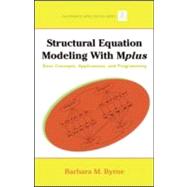
Note: Supplemental materials are not guaranteed with Rental or Used book purchases.
Purchase Benefits
Looking to rent a book? Rent Structural Equation Modeling with Mplus: Basic Concepts, Applications, and Programming [ISBN: 9781848728394] for the semester, quarter, and short term or search our site for other textbooks by Byrne; Barbara M.. Renting a textbook can save you up to 90% from the cost of buying.
| Preface | p. xi |
| Acknowledgments | p. xvii |
| Introduction | |
| Structural Equation Models: The Basics | p. 3 |
| Basic Concepts | p. 4 |
| The General Structural Equation Model | p. 9 |
| The General Mplus Structural Equation Model | p. 15 |
| Notes | p. 17 |
| Using the Mplus Program | p. 19 |
| Mplus Notation and Input File Components and Structure | p. 19 |
| The Mplus Language Generator | p. 26 |
| Model Specification From Two Perspectives | p. 27 |
| The Concept of Model Identification | p. 31 |
| Overview of Remaining Chapters | p. 39 |
| Notes | p. 40 |
| Single-Group Analyses | |
| Testing the Factorial Validity of a Theoretical Construct: First-Order Confirmatory Factor Analysis Model | p. 43 |
| The Hypothesized Model | p. 43 |
| Mplus Input File Specification and Output File Results | p. 48 |
| Hypothesis 2: Self-Concept Is a Two-Factor Structure | p. 89 |
| Mplus Input File Specification and Output File Results | p. 89 |
| Hypothesis 3: Self-Concept Is a One-Factor Structure | p. 91 |
| Notes | p. 93 |
| Testing the Factorial Validity of Scores From a Measuring Instrument: First-Order Confirmatory Factor Analysis Model | p. 95 |
| The Measuring Instrument Under Study | p. 96 |
| The Hypothesized Model | p. 96 |
| Mplus Input File Specification and Output File Results | p. 101 |
| Notes | p. 121 |
| Addendum | p. 122 |
| Testing the Factorial Validity of Scores From a Measuring Instrument: Second-Order Confirmatory Factor Analysis Model | p. 125 |
| The Hypothesized Model | p. 126 |
| Analysis of Categorical Data | p. 126 |
| Mplus Input File Specification and Output File Results | p. 133 |
| Notes | p. 146 |
| Testing the Validity of a Causal Structure: Full Structural Equation Model | p. 147 |
| The Hypothesized Model | p. 147 |
| Mplus Input File Specification and Output File Results | p. 153 |
| Post Hoc Analyses | p. 168 |
| Notes | p. 188 |
| Multiple-Group Analyses | |
| Testing the Factorial Equivalence of a Measuring Instrument: Analysis of Covariance Structures | p. 193 |
| Testing Multigroup Invariance: The General Notion | p. 194 |
| Testing Multigroup Invariance Across Independent Samples | p. 197 |
| The Hypothesized Model | p. 197 |
| Mplus Input File Specification and Output File Results | p. 208 |
| Notes | p. 226 |
| Testing the Equivalence of Latent Factor Means: Analysis of Mean and Covariance Structures | p. 227 |
| Testing Latent Mean Structures: The Basic Notion | p. 227 |
| The Hypothesized Model | p. 231 |
| Testing Multigroup Invariance | p. 231 |
| Mplus Input File Specification and Output File Results | p. 241 |
| Testing Multigroup Invariance: Other Considerations | p. 254 |
| Notes | p. 257 |
| Testing the Equivalence of a Causal Structure: Full Structural Equation Model | p. 259 |
| Cross-Validation in Structural Equation Modeling | p. 259 |
| Testing Invariance Across Calibration and Validation Samples | p. 261 |
| The Hypothesized Model | p. 262 |
| Mplus Input File Specification and Output File Results | p. 264 |
| Notes | p. 282 |
| Other Important Topics | |
| Testing Evidence of Construct Validity: The Multitrait-Multimethod Model | p. 285 |
| The General CFA Approach to MTMM Analyses | p. 286 |
| The Hypothesized Model | p. 287 |
| Mplus Input File Specification and Output File Results | p. 288 |
| Examining Evidence of Construct Validity at the Matrix Level | p. 295 |
| Examining Evidence of Construct Validity at the Parameter Level | p. 301 |
| The Correlated Uniquenesses Approach to MTMM Analyses | p. 303 |
| Notes | p. 311 |
| Testing Change Over Time: The Latent Growth Curve Model | p. 313 |
| Measuring Change in Individual Growth Over Time: The General Notion | p. 316 |
| The Hypothesized Dual-Domain LGC Model | p. 316 |
| Mplus Input File Specification and Output File Results | p. 321 |
| Hypothesized Covariate Model: Age and Surgery as Predictors of Change | p. 338 |
| Notes | p. 344 |
| Testing Within- and Between-Level Variability: The Multilevel Model | p. 345 |
| Overview of Multilevel Modeling | p. 346 |
| The Hypothesized Model | p. 350 |
| Mplus Input File Specification and Output File Results | p. 354 |
| Notes | p. 371 |
| References | p. 373 |
| Author Index | p. 395 |
| Subject Index | p. 401 |
| Table of Contents provided by Ingram. All Rights Reserved. |
The New copy of this book will include any supplemental materials advertised. Please check the title of the book to determine if it should include any access cards, study guides, lab manuals, CDs, etc.
The Used, Rental and eBook copies of this book are not guaranteed to include any supplemental materials. Typically, only the book itself is included. This is true even if the title states it includes any access cards, study guides, lab manuals, CDs, etc.